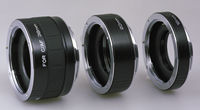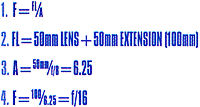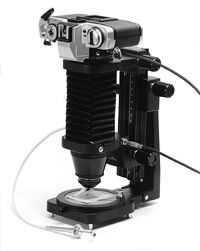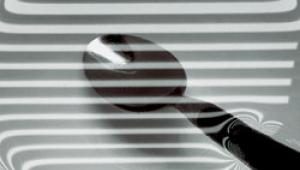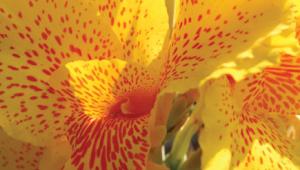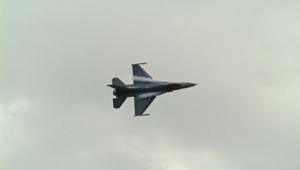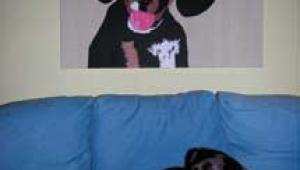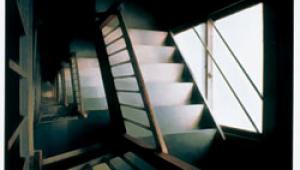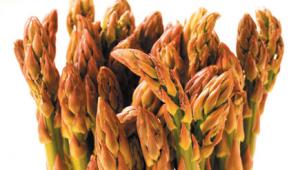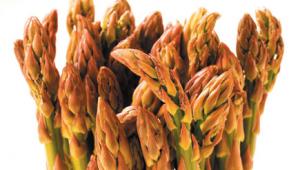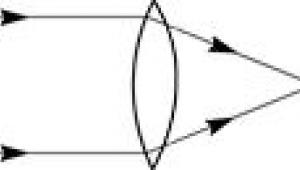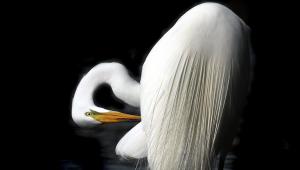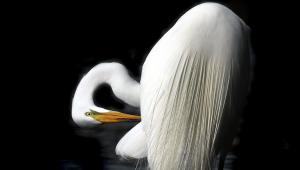Photographic Super Course: Macro Photograqphy Page 2
| Extension Tubes Not terribly exotic in theory, extension tubes are just light-tight spacers that fit between the camera body and the lens. They don't contain any glass elements; they merely increase the distance between the optical center of the lens and the film, thus producing magnification of the image. Since they contain no glass elements, extension tubes don't degrade image quality as close-up lenses do. For greater extension (and thus, greater magnification), you can combine two or more extension tubes. The extension tube attaches to the camera body; the lens attaches to the extension tube. The degree of magnification depends on the length of the extension tube relative to the focal length of the lens being used with it. When the extension tube is the same length as the focal length of the lens attached to it (for example, a 50mm extension tube with a 50mm lens), a life-size or 1:1 reproduction ratio results: the image of the subject will appear life-size on the film. If the extension tube is longer than the focal length of the lens, greater-than-life-size magnification is achieved. From the foregoing, you can deduce that the shorter the focal length of the camera lens, the greater the magnification produced by a given extension tube. A 50mm extension tube with a 50mm lens yields a life-size image on the film; the 50mm tube with a 24mm lens yields a twice-life-size (2:1) image. The instruction manual that comes with the extension tubes contains tables that indicate what the magnification will be with a given tube and various camera-lens focal lengths, but it's easy to calculate for yourself: Just divide the length of the extension tube by the focal length of the lens, and the result is the magnification produced by the combination (for example, a 50mm tube divided by a 200mm lens focal length equals an 0.25X or 1/4-life-size "magnification"). When you increase the distance between the film and the optical center of the lens (as is the case when you are using extension tubes or the soon-to-be-discussed bellows units), you also reduce the amount of light transmitted to the film, because the diameter of the lens aperture is smaller relative to the overall focal length of the lens/extension combination. Fortunately, your camera's built-in through-the-lens exposure meter will automatically compensate for this loss of light. But if you use a hand-held meter, you must remember to compensate for the loss of light caused by using the extension tube(s) or bellows. The formula to do this is fairly simple: f = FL/A, where f is the effective f-number of the lens/extension-tube combination, FL is the effective focal length of the combination and A is the diameter of the lens aperture. Here's an example: If you're using a 50mm extension tube with a 50mm camera lens set at f/8, FL = 100mm (50mm lens plus 50mm tube), and A = 6.25mm (50mm lens divided by the set f number of f/8). Therefore, f = 16 (100 divided by 6.25). This means that, when the 50mm lens is set at f/8 and attached to a 50mm extension tube, the effective f-stop of the combination if f/16—two stops smaller than f/8. So you must give the shot two stops of additional exposure to compensate for the light lost due to the extension. Aren't you glad that 35mm SLRs come with built-in TTL meters that compensate for this light loss automatically? Some extension tubes and bellows are not "automatic." This means the linkage between the camera and lens that tells the built-in meter which aperture the lens is set at is disconnected. With nonautomatic extension tubes, you must use stopped-down metering, whereby you stop the lens down manually to the selected aperture, so the meter can read the light actually transmitted by the lens/extension-tube combination at that aperture. See your camera or extension-tube manual for specifics. Aside from the light loss caused by the extension, the biggest drawback to extension tubes is that the lens won't focus out to infinity when attached to one—but, then, you aren't using extension tubes to shoot distant subjects; you're using them for close-up work. Note: The camera lens won't focus out to infinity when a close-up lens or bellows is attached, either. Bellows Units The unit consists of an accordionlike bellows with a camera mount on one end and a lens mount on the other, and a support rod to hold the mounts. The camera body attaches to the camera mount (generally referred to as the rear standard). Some bellows permit the camera body to be rotated for easy vertical-format shots. The lens attaches to the bellows' front standard. The entire bellows assembly attaches to a focusing rail, which in turn attaches the assembly to a tripod. The knob on the focusing rail gradually moves the whole assembly forward or backward for precise control of focusing. The focusing rail is marked in millimeters so you can readily figure out how much extension is being used, and set the desired amount. Tables in the bellows instruction manual tell you how much extension to use to produce a given magnification with a given lens, and how much exposure compensation is necessary. You can mount the bellows on the focusing rail sideways and use the focusing rail to move the camera to shoot several frames of a subject that is too large to cover in one shot, while retaining a precise magnification. A rotating lens standard, available on some bellows units, allows you to reverse the lens so that it points toward the camera with its rear element facing out. Reversing a normal lens provides slightly greater magnification, and sharper results in close-up work. For extreme magnification, there are special bellows lenses. These have no focusing mounts of their own; they rely on physical movement toward or away from the subject for focusing. But in practice, so does any lens attached to a bellows. Bellows lenses are optimized for high-magnification work, and are a good choice for really serious macro shooters. The main disadvantage of a bellows is the same as an extension tube's—loss of light due to the extension of the lens-to-film distance. As with extension tubes, a 35mm SLR's through-the-lens exposure meter will compensate for this with auto bellows units. Also, the bellows instruction manual includes exposure-compensation tables for various magnifications. Slide copiers attach to the bellows-mounted lens and permit not only copying slides, but cropping in on them and adding special effects with filters. Note: Simple self-contained slide-duplicators that attach directly to the camera are also available. These are less costly and less versatile than bellows slide copiers. Another very useful bellows accessory is the macro stand, which holds both bellows and subject in position for sharp, precise close-up images. |
- Log in or register to post comments


